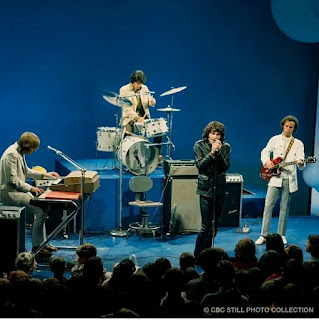THE DOORS' "RIDERS ON THE STORM”: HOW THE RAIN EFFECT IS USED
Many groups in England and the United States in the 60s and 70s frequently used the technique of adding sound effects to their recordings to make the images evoked by a song more vivid and vibrant.
One example among many is the beautiful pop-rock of "This
Time Tomorrow" by the Kinks, released in 1970 as part of the album
"Lola Versus Powerman and the Moneygoround, Part One".
Here, a departing plane communicates to the listener
what is later developed in the lyrics: a journey with an unknown destination.
This quite common practice is also used by The Doors
in one of their last songs recorded with the original lineup: "Riders
On The Storm", which is included on "L.A. Woman," the band's final LP with
Jim Morrison (released in April 1971).
In this famous song, the chosen sound is that of rain during a
thunderstorm. It is included at the beginning of the song and then remains
present as a background throughout the entire composition.
Sometimes the sound is clearly audible, sometimes it
is overpowered by the instruments, but it never disappears completely.
It adds to the almost cinematic character of the song,
juxtaposing its sound atmosphere with that of a film noir.
In the finale, the described studio effect returns as
the only element (from min. 6.46 onward), just like it happened at the
beginning of the song.
In this composition, the group uses rain and thunder with a specific role: to serve as an evocative accompaniment and sonic commentary to the story emerging from Morrison's profound lyrics.
In addition to being directly related to the title of
the song (the word "Storm"), the thunderstorm we hear in "Riders
On The Storm" allows us to enter with even greater intensity into the words sung by the singer's dark and deep voice.
Far from being a mere gimmick to intrigue the
listener, this sound effect is an integral part of the performance, suggesting
a precise key to interpretation and complementing the lyrics and
instrumentation.
In this context, the rain and thunder are given as much importance as the other elements that bring the arrangement to life, becoming
almost as important as the drums and electric bass.
The result is an ambitious and daring artistic leap
that expands and enriches The Doors' musical and conceptual output.
To better understand how innovative the studio work
done by The Doors on "Riders On The Storm" is (in this case with
Bruce Botnik as sound engineer and producer), we can cite two examples of the
use of rain in songs of that period.
The first example is "Flowers in The
Rain" by The Move, a pop-rock song released in August 1967 that
reached number two as a single in England.
The sound of rain is used here only at the beginning
and then disappears completely, constituting only a brief introduction with a
purely illustrative purpose.
In this case, the rain studio effect merely suggests an image contained in the lyrics. So, it has no connection to the song's progression, arrangement, or structure.
The second example is "Black Sabbath",
the opening track of Black Sabbath's eponymous debut album (released in
February 1970).
The sound of rain and thunder opens the song with a specific purpose: to establish the heavy, gloomy atmosphere that defines the composition and make it more haunting to the listener.
Rain and thunder play a role in the song "Black
Sabbath" that we can thus frame as symbolic, and that is significantly more
evolved and complex than that achieved by The Move in "Flowers In The
Rain."
To sum up, the role of this studio effect evolves from
merely illustrative (in "Flowers In The Rain") to symbolic
(in "Black Sabbath"), and finally to a narrative and complementary role in the arrangement of "Riders On The Storm".
With the poetic sound of the thunderstorm we hear in
"Riders On The Storm", The Doors prove themselves to be innovative and pioneering musicians, as they had done
at other times throughout their career.
In the recording studio the Californian band applies this particular natural sound to vividly document an artistic vision far more articulate than that of most contemporary and subsequent groups and artists.
P.S.: My book "The Doors Through Strange Days"- The most comprehensive journey ever made through The Doors' second LP, is available on Amazon.com, .uk, .mx, .it, etc.
Here’s a link:




Comments
Post a Comment